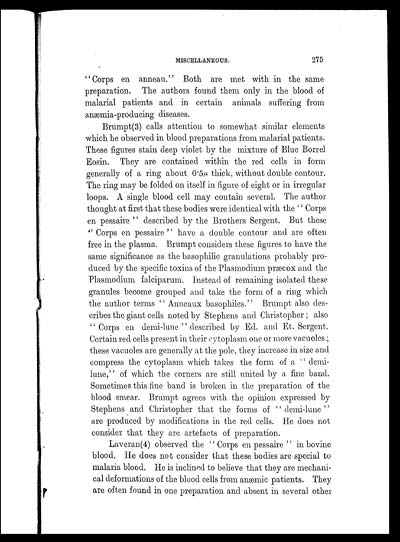Medicine - Veterinary > Civil Veterinary Departments > Indian Civil Veterinary Department memoirs > No. 3 - Report of the research work of the Imperial Bacteriological Laboratory Muktesar during 1910 & 1911
(586) Page 275
Download files
Individual page:
Thumbnail gallery: Grid view | List view

MISCELLANEOUS. 275
"Corps en anneau." Both are met with in the same
preparation. The authors found them only in the blood of
malarial patients and in certain animals suffering from
anæmia-producing diseases.
Brumpt(3) calls attention to somewhat similar elements
which he observed in blood preparations from malarial patients.
These figures stain deep violet by the mixture of Blue Borrel
Eosin. They are contained within the red cells in form
generally of a ring about 0?5µ thick, without double contour.
The ring may be folded on itself in. figure of eight or in irregular
loops. A single blood cell may contain several. The author
thought at first that these bodies were identical with the '' Corps
en pessaire " described by the Brothers Sergent. But these
" Corps en pessaire " have a double contour and are often
free in the plasma. Brumpt considers these figures to have the
same significance as the basophilic granulations probably pro-
duced by the specific toxins of the Plasmodium præcox and the
Plasmodium falciparum. Instead of remaining isolated these
granules become grouped and take the form of a ring which
the author terms " Anneaux basophiles." Brumpt also des-
cribes the giant cells noted by Stephens and Christopher ; also
'' Corps en demi-lune '' described by Ed. and Et. Sergent.
Certain red cells present in their cytoplasm one or more vacuoles ;
these vacuoles are generally at the pole, they increase in size and
compress the cytoplasm which takes the form of a " demi-
lune," of which the corners are still united by a fine band.
Sometimes this fine band is broken in the preparation of the
blood smear. Brumpt agrees with the opinion expressed by
Stephens and Christopher that the forms of " demi-lune "
are produced by modifications in the red cells. He does not
consider that they are artefacts of preparation.
Laveran(4) observed the " Corps en pessaire " in bovine
blood. He does not consider that these bodies are special to
malaria blood. He is inclined to believe that they are mechani-
cal deformations of the blood cells from anæmic patients. They
are often found in one preparation and absent in several other
Set display mode to: Large image | Zoom image | Transcription
Images and transcriptions on this page, including medium image downloads, may be used under the Creative Commons Attribution 4.0 International Licence unless otherwise stated. ![]()
| Permanent URL | https://digital.nls.uk/75514292 |
|---|
| Shelfmark | IP/RA.10. |
|---|---|
| Additional NLS resources: | |




